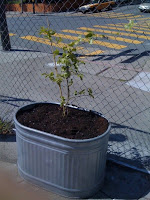 Hello Friends of the Garden!
Hello Friends of the Garden!
This last Saturday workday was quite a day. Not getting rained out was a big plus! We started early with two volunteers coming in before the official 10 o'clock start time. That's a serious go-getter attitude.
A lot of our gathered materials had been left near the front of the site making our space look haphazard. We hauled the lumber, pallets, and odds n' ends down to be sorted, stacked, and organized. It wasn't long before our helter skelter piles of materials started looking like they were supposed to be there. This lot has been left unattended for years so getting it in shape can be a big job; trash has collected, weeds have sprung up all over, but we're starting to show the space the love it deserves. This is the part in the movie where the nerdy abandoned lot with box frame glasses, using a pencil to hold its hair in a bun gets a make over. "Oh my God, St. Paulus, you're simply breathtaking!"

The lot really is beautiful. We've run a gas-powered weed eater through the area which not only makes the grounds look better kempt but those small clippings can also be layer with manure to mature it, leading to food for plants! Even manure's gotta grow up some time.
A lot of sweat and time was spent in creating a foot-path ramp to allow easier access into the large farm space. We loaded down wheelbarrows with dirt from the site and slowly built up our ramp. There's more work to be done there, but in one day we got so far! We have a two-fold plan for the ramp. First, we take dirt from a large hill and use that dirt to create the ramp. Second, while removing the dirt we level off the hill in order to make a clean area for a demonstration garden near the front. In the future we'll show folks in the demo garden what can be grown at certain times of the year and use it as an opportunity for gardening education. I think everyone in the project is excited to share our knowledge, experience, failures, and successes with others interested in growing their own food in the city.
Pastor Megan spent a lot of time finishing a beautiful tool shed to house our tools in! Hooray for not having to carry things from an overcrowded Pastor's office to garden and back! That was seriously cramping my style. After this Saturday workday the shed

is sporting a sassy new coat of light blue paint. We're trying to teach this gray San Francisco sky what it should be doing. Doesn't seem to be listening.
Throughout the day there were lots of folks walking past stopping in to talk. You wouldn't believe how many gardeners there are in one block of the city. There are plenty of helping hands to be found. Four volunteers on Saturday (including yours truly) were Lutheran Volunteer Corps members (Thanks Margaret, Troy and Katie!), two volunteers were from just down the street, two more volunteers heard about the workday through Tree, and two more volunteers heard about the workday through Pastor Megan. Word gets around!
That's the news from the farm this week. I hope to see you out there Saturday from 10am -
2pm! Don't forget to bring a friend!

 This morning, at Bethlehem Lutheran I attached some potato and onion sacks to the fence to serve as a barrier to keep the soil inside the garden. In order to make it prettier, I also planted some succulents along the fence. Their roots will not only hold the soil in place, but it also grow strong with out much water.
This morning, at Bethlehem Lutheran I attached some potato and onion sacks to the fence to serve as a barrier to keep the soil inside the garden. In order to make it prettier, I also planted some succulents along the fence. Their roots will not only hold the soil in place, but it also grow strong with out much water.



















































